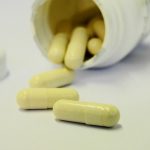
Glutathione is a key component used by the body as an antioxidant. It is produced by a number of tissues but the main centre of production is the liver.
The Structure And Basic Synthesis Of Glutathione
Glutathione is composed of three amino acids: glycine, cysteine and glutamine. It is produced in a two-step enzymatic process. In the first step, two amino-acids glutamate and cysteine are joined to form gamma-glutamylcysteine (GGC). The second step involves addition of glycine to CGC and glutathione is produced. The formtaion of L-cysteine is the rate-limiting step meaning that this particular amino acid control production of glutathione.
When the body is stressed, the levels of glutathione drops. It drops when nutrition is poor or when environmental toxins or when stress is high. Levels also drop as we get older. The age-related effect is due to the cell’s capacity for production of the enzymes dropping away. The first enzyme in particular is degraded and so not enough GGC is produced for the whole body’s needs. Without glutathione, free radical damage occurs to DNA as well as other cellular structures. This level accelerates which hastens the senescence of the cells.
Forms Of Glutathione
There are two different forms of glutathione:
-
Reduced glutathione (GSH, or L-glutathione) is the active form. It repairs oxidative damage and oxidizes, becoming—
-
Oxidized glutathione (GSSG) is the inactive form, which can be recycled back into active GSH.
Whilst we produce glutathione naturally, we can take it as a supplement in capsule and liquid form, as an inhalant or sometimes given intravenously.
Main Benefits Of Glutathione
Minimises Oxidative Stress
When we suffer oxidative stress our cells suffer an imbalance in the production of free radicals which we have to deal with. Indeed, we often call it the body’s ‘master antioxidant’. At the biochemical level it is used for DNA synthesis and repair, for protein and prostaglandin synthesis, amino acid transport etc.
The benefits that develop from reducing oxidative stress are many fold. Here they are there:
- It increases energy provision to the cells.
- Slows down the aging process
- Detoxifies the liver and other cells involved in chemical reactions by involved in toxin and carcinogen metabolism.
- Improves mental focus and acuity
- Reduces the effects of stress
- Improves the skin
- Reduces psoriasis
- Helps improve sports and athletic performance.
- Reduces muscle and joint discomfort
- May help in reducing autoimmune disease
Energy Production
the mitochondria are the main centres for energy production in the cell except for red blood cells. Gluthione protectcts mitochondria from damage as energy production progresses. When mirochondria are damaged, their manufacture of energy molecules slows down and they make less of them. As a result teh cells capcaity to survive drops. In turn, they produce more free radicals which causes increasing amounts of cellular damage.
The presence of GSH helps to reduce free radical damage by binding to them. One of the main elements in reducing oxidative damage to the cell.
Skin Protection And Skin Whitening
Glutathione helps reduce melanin production in the skin. Melanin is the main pigment in freckles and darkening skin due to sun damage. The compound inhibits the enzyme tyrosinase which is invlved in melanin production. Thus, it is often added to skin whitening creams to increase the skin’s paleness.
In psoriasis, glutathione will decrease its impact. It also improves skin elasticity and reduce s wrinkling. It is thus a good anti-aging compound.
Supplementation
Supplementation is often problematic because it is so reactive. The molecule readily breaks up into its component amino acids. It is also badly absorbed in the gut.
Please not this article contains links to our affiliate marketing partner. Please read our affiliate disclosure.
References
Zarka, M.H., Bridge, W.J. (2017) Oral administration of γ-glutamylcysteine increases intracellular glutathione levels above homeostasis in a randomised human trial pilot study. Redox Biol. 11 pp. 631‐636. (Article) doi:10.1016/j.redox.2017.01.014



Leave a Reply